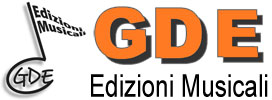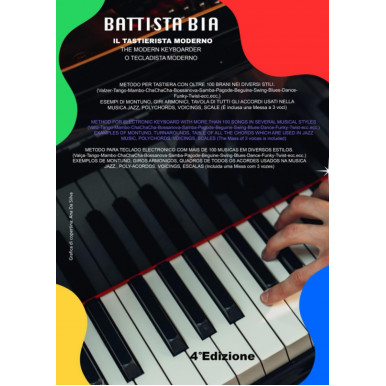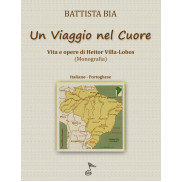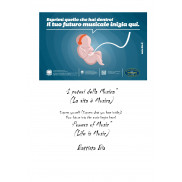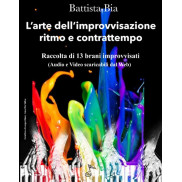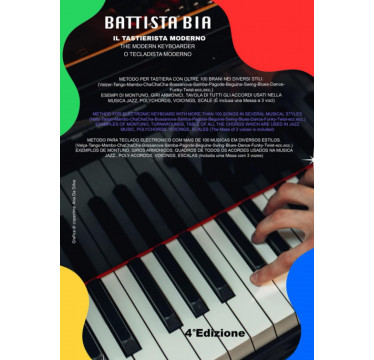Il tuo carrello è vuoto!
Descrizione
Il tastierista moderno
BATTISTA BIA
IL TASTIERISTA MODERNO
METODO PER TASTIERA CON OLTRE 100 BRANI NEI DIVERSI STILI. (Valzer-Tango-Mambo-ChaChaCha-Bossanova-Samba-Pagode-Beguine-Swing-Blues-DanceFunky-Twist-ecc,ecc.). ESEMPI DI MONTUNO, GIRI ARMONICI, TAVOLA DI TUTTI GLI ACCORDI USATI NELLA MUSICA JAZZ, POLYCHORDS, VOICINGS, SCALE (È inclusa una Messa a 3 voci). METHOD FOR ELECTRONIC KEYBOARD WITH MORE THAN 100 SONGS IN SEVERAL MUSICAL STYLES (Valtz-Tango-Mambo-ChaChaCha-Bossanova-Samba-Pagode-Beguine-Swing-Blues-DanceFunky-Twist-ecc.ecc.). EXAMPLES OF MONTUNO, TURNAROUNDS, TABLE OF ALL THE CHORDS WHICH ARE USED IN JAZZ MUSIC, POLYCHORDS, VOICINGS, SCALES (The Mass of 3 voices is included). METODO PARA TECLADO ELECTRONICO COM MAIS DE 100 MUSICAS EM DIVERSOS ESTILOS. (Valça-Tango-Mambo-ChaChaCha-Bossanova-Samba-Pagode-Beguine-Swing-Blues-DanceFunky-Twist-ecc.ecc.). EXEMPLOS DE MONTUNO, GIROS ARMONICOS, QUADROS DE TODOS OS ACORDES USADOS NA MUSICA JAZZ., POLY-ACORDOS, VOICINGS, ESCALAS (Incluida uma Missa com 3 vozes).
.....................................................................................
Il Tastierista moderno, è un metodo per tastiere pubblicato con vari Editori, sin dagli inizi degli anni ’70. L’ultima edizione, edita da Carisch S.P.A. risale all’anno 2.000. Il metodo è ricco di musiche inedite, determinanti per un valido supporto a imparare a leggere la Musica. Le musiche sono state composte su tutti i ritmi e stili musicali, per dare un ampia visione agli alunni. La seconda parte ha una buona infarinatura di nozioni jazz, con brani per Pianoforte Jazz, dagli accordi base fino alle 13^esime, ai voicing in tutte le tonalità, ai giri armonici, alcuni esempi di montunho, posizioni dissonanti su accordi composti. Alla fine è stata inserita anche una Messa a 3 voci del compositore. Libro completo e consigliato sia ai principianti che ai più esperti.
L’Autore
Description
The modern keyboard player is a keyboard method published since the early 1980s. The latest edition, published by Carisch S.P.A. dates back to the year 2,000. The method is full of unpublished music, crucial for a valid support in learning to read music. The music was composed on all rhythms and musical styles, to give a broad vision to the pupils. The second part has a good smattering of jazz notions, with piano pieces, from chords up to the 13th, to voicings in all keys, harmonic turns, some examples of montunho, dissonant positions on compound chords. At the end, a 3-part Mass by the composer was also inserted. Complete book and recommended for both beginners and more experienced.
.....................................................................................
Il Tastierista moderno, è un metodo per tastiere pubblicato con vari Editori, sin dagli inizi degli anni ’70. L’ultima edizione, edita da Carisch S.P.A. risale all’anno 2.000. Il metodo è ricco di musiche inedite, determinanti per un valido supporto a imparare a leggere la Musica. Le musiche sono state composte su tutti i ritmi e stili musicali, per dare un ampia visione agli alunni. La seconda parte ha una buona infarinatura di nozioni jazz, con brani per Pianoforte Jazz, dagli accordi base fino alle 13^esime, ai voicing in tutte le tonalità, ai giri armonici, alcuni esempi di montunho, posizioni dissonanti su accordi composti. Alla fine è stata inserita anche una Messa a 3 voci del compositore. Libro completo e consigliato sia ai principianti che ai più esperti.
L’Autore
Description
The modern keyboard player is a keyboard method published since the early 1980s. The latest edition, published by Carisch S.P.A. dates back to the year 2,000. The method is full of unpublished music, crucial for a valid support in learning to read music. The music was composed on all rhythms and musical styles, to give a broad vision to the pupils. The second part has a good smattering of jazz notions, with piano pieces, from chords up to the 13th, to voicings in all keys, harmonic turns, some examples of montunho, dissonant positions on compound chords. At the end, a 3-part Mass by the composer was also inserted. Complete book and recommended for both beginners and more experienced.
Recensioni (0)
Scrivi una recensione
Il Tuo Nome:La Tua Recensione:
Nota: Il codice HTML non è tradotto!
Punteggio: Negativo Positivo
Inserisci il codice nel box di seguito:
